- Register / Login
A password will be e-mailed to you

Reset Password

BRISTOL CHANNEL CUTTER
More information, image gallery, floor plans.
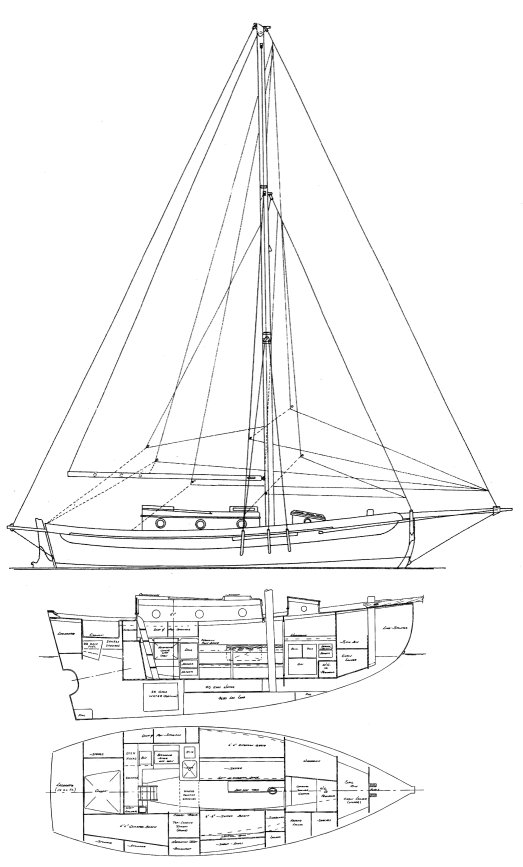
Use the form below to contact us!
Bristol channel cutter
The bristol channel cutter is a 28.08ft cutter designed by lyle hess and built in fiberglass by cape george marine works between 1976 and 2007., 127 units have been built..
The Bristol channel cutter is a heavy sailboat which is a good performer. It is stable / stiff and has an excellent righting capability if capsized. It is best suited as a bluewater cruising boat. The fuel capacity is originally small. There is a short water supply range.
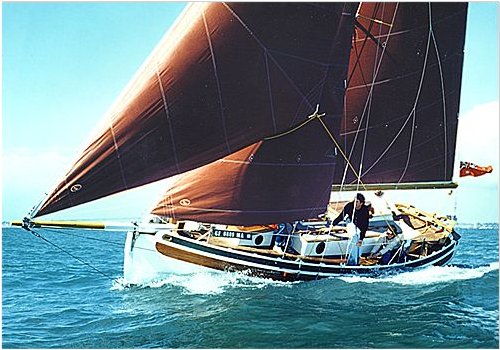
Bristol channel cutter for sale elsewhere on the web:

Main features
| Model | Bristol channel cutter | ||
| Length | 28.08 ft | ||
| Beam | 10.08 ft | ||
| Draft | 4.83 ft | ||
| Country | United states (North America) | ||
| Estimated price | $ 0 | ?? |
Login or register to personnalize this screen.
You will be able to pin external links of your choice.

See how Sailboatlab works in video
| Sail area / displ. | 18.60 | ||
| Ballast / displ. | 32.86 % | ||
| Displ. / length | 345.54 | ||
| Comfort ratio | 37.20 | ||
| Capsize | 1.68 |
| Hull type | Monohull long keel with transom hung rudder | ||
| Construction | Fiberglass | ||
| Waterline length | 26.25 ft | ||
| Maximum draft | 4.83 ft | ||
| Displacement | 14000 lbs | ||
| Ballast | 4600 lbs | ||
| Hull speed | 6.87 knots |

We help you build your own hydraulic steering system - Lecomble & Schmitt
| Rigging | Cutter | ||
| Sail area (100%) | 673 sq.ft | ||
| Air draft | 0 ft | ?? | |
| Sail area fore | 0 sq.ft | ?? | |
| Sail area main | 0 sq.ft | ?? | |
| I | 0 ft | ?? | |
| J | 0 ft | ?? | |
| P | 0 ft | ?? | |
| E | 0 ft | ?? |
| Nb engines | 1 | ||
| Total power | 13 HP | ||
| Fuel capacity | 30 gals |
Accommodations
| Water capacity | 64 gals | ||
| Headroom | 0 ft | ||
| Nb of cabins | 0 | ||
| Nb of berths | 0 | ||
| Nb heads | 0 |
Builder data
| Builder | Cape George Marine Works | ||
| Designer | Lyle Hess | ||
| First built | 1976 | ||
| Last built | 2007 | ||
| Number built | 127 |
Other photos

Modal Title
The content of your modal.
Personalize your sailboat data sheet
Introduction
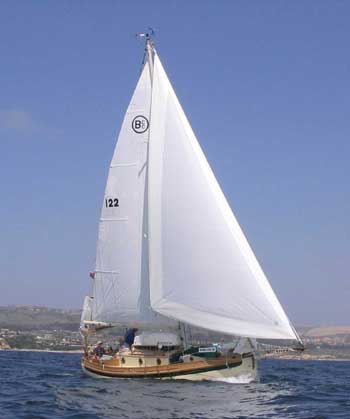
Few boats are built today that will withstand many years of punishment from blue water cruising. Lyle Hess designed boats just for that purpose. His designs have been proven by Lin and Larry Pardey aboard Seraffyn and Teleisin and the many Bristol Channel Cutter owners who have ventured across the oceans. Everything about the Bristol Channel Cutter’s design exudes seaworthiness. Not only is she stouthearted but will surprise most with her sailing performance both in light and heavy airs.
Take careful note of her lines and how the water will flow undisturbed from her stem to the transom. The flat buttocks and flatness of the hull at the stem prevent her from squatting as she reaches hull speed.
The generous sail area and long water line give her remarkable speeds in even light airs. Large headsails may be carried due to the long “J” measurement created by the bowsprit. Combined with the staysail, slot effect is exceptional providing excellent windward ability.
Her spiritual aunts, 24-foot Seraffyn (1969 to 1980) and 29-foot Taleisin (1983 to the present), both also from the Hess’s board and from similar models, logged many tens of thousands of blue water miles. These included an 11-year circumnavigation for Seraffyn and some 40,000 miles and five passages of the Tasman Sea for Taleisin through 1994.
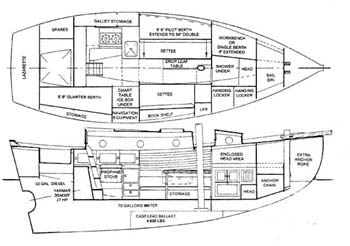
A BCC was first overall in the 1978 Newport to Ensenada Race and first in class in the 1979 running. A BCC named Xiphias logged a 13-year, two-ocean, 50,000-mile odyssey, during the 1980s and 1990s. It sailed 3,150 nautical miles from Dana Point, California, to Nuku Hiva, Marquesas, in 22 days, 10 hours, averaging 140 miles per day, with a best day’s run of 180 miles, on a 26’3′ waterline.
The accommodation of the BCC is so intricately laid out that most owners find that even the smallest modifications have implications elsewhere below. Sea berths abound, and stowage is everywhere. One owner catalogs 44 different stowage areas. Fuel and water tanks are below the waterline for low center of gravity.
The BCC’s fine entry and maximum beam well aft combine for good windward performance. Her flat run aft enhances speed and adds buoyancy in following seas. The angle of her quarter-beam buttock (23 at the transom) gives her stiffness under a press of sail.
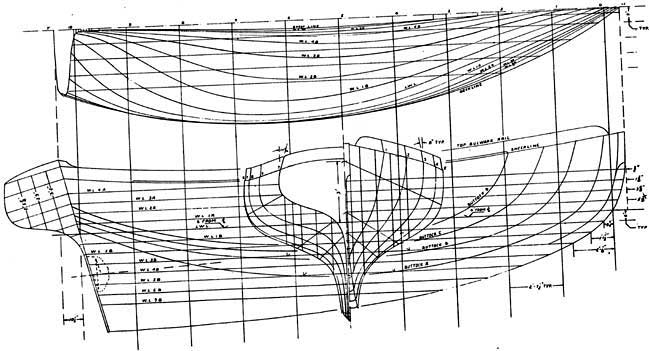
Much has been written about the Bristol Channel Cutter from the Sam L. Morse Company, and we will let these articles speak for themselves:
Boat US Review, May 2005 Cruising World Boats.com
- BOAT OF THE YEAR
- Newsletters
- Sailboat Reviews
- Boating Safety
- Sails and Rigging
- Maintenance
- Sailing Totem
- Sailor & Galley
- Living Aboard
- Destinations
- Gear & Electronics
- Charter Resources

Bristol Channel Cutter 28
- By Barbara Marrett
- Updated: November 4, 2001

The Bristol Channel Cutter caused a veritable traffic jam at the 1995 Annapolis Boat Show. Certainly she is a niche boat with a fiercely loyal following among long-distance cruisers. Cruiser/authors Lin and Larry Pardey, whose boats Seraffyn and Taleisin are also Lyle Hess designs, have always been big proponents of her style. Traditional lines, a long full keel and heavy displacement set her apart from many modern cruising boats.
Careful workmanship and structural integrity are givens. The hull is hand-laid and squeegeed to optimize the fabric-to-resin ratio. Up to 10 layers of mat, roving and cloth combine to form a thickness that ranges from 3/8-inch at the sheer to a whopping one to 11/2 inches at the bottom of the hull; additional reinforcement can be found in the chain plate area. The hull comes protected with three coats of epoxy barrier coat to retard osmotic blistering.
Deck construction features marine plywood core. While it is heavier than balsa core and does not enjoy the same core-skin shear strength, marine ply has good compressive strength and will not absorb water readily if holed or drilled in an unexpected area.
Below the waterline, the cutter is built to take the abuse of long-distance passage making and the bumps and bruises that follow inevitably from poking into uncharted anchorages. The 5’1″ full keel is formed from pre-cast lead ballast that is completely resin encapsulated, then covered with mat and roving. The double-spreader aluminum mast is stepped solidly on this substantial keel. The rudder is transom hung, not only making it easy to remove and repair but also enabling it to protect the propeller in an aperture behind the keel.
The hull-to-deck joint is sealed in 3M 5200, then fastened with 1/4-inch stainless steel bolts on five-inch centers. The deck joint is strengthened further by the addition of bulwark stanchions installed every 20 inches using 1/2-inch stainless bolts.
Wide side decks flanked by 28-inch lifelines and eight-inch-high teak bulwarks provide exceptional security whenever you venture forward. Shrouds and chain plates fastened outboard provide an unobstructed passage fore and aft. Double anchor rollers fitted to a sturdy bracket on the bowsprit increase the options for anchoring in tight spaces.
Cockpit seats are flush with the deck. Board inserts span the cockpit well and cushions from below fit into this space to make a double bed topside beneath the stars, with a thin 10-inch-high wood cockpit coaming separating the enclosure from the side decks. The companionway entrance is protected by a sizable bridge deck, lessening the chances of green water spilling below even if the hatchboards are left out inadvertently.
The headsail attached to the end of a six-foot bowsprit moves the center of effort forward for improved off-the-wind performance and a more balanced helm. The trade-off is that, even with roller furling, if the sail becomes jammed or must be changed one has to go forward and sit on the end of the bowsprit to complete the task. The cutter rig does, however, offer nice balance between the staysail (deck mounted) and the main or storm trysail when the going gets tough.
Solid construction in hull and deck add up to a formidable heavy displacement boat. Despite its modest length (28 feet on deck), the Bristol Channel Cutter has the ability to carry a sizable payload of cruising equipment and provisions. The disadvantages include slow performance and compromised maneuverability in light air. However, in many people’s minds heavy displacement equates to seaworthiness. I sense that the boat may be overbuilt, but in the end this is a judgment call that anybody faced with an evening aground on an uncharted reef might energetically dispute.
Because the rudder is not balanced, all mechanical advantage is provided by the tiller. Manning the helm for any significant amount of time without tackle led to bear weather load is apt to be strenuous. Prolonged steering is probably best accomplished by sail trim, wind vane or autopilot, for which the boat is by design exquisitely adapted; a simple wind vane operating off a trim tab on the rudder steered better than we could in our light-air Chesapeake Bay testing venue.
I’ve been impressed by consistent reports of good blue-water performance by owners of these venerable craft.
The interior is entirely hand fabricated; no liners are used. What this means is easy access to the hull and flexibility in interior layout. There are three basic layout options, but you can semi-customize your cutter in a lot of cases without extra cost. Below, the boat exudes quiet, snug warmth. Classic touches such as bronze ports, an opening teak skylight and brass decorative plates for ventilation recall 19th century craftsmanship and careful attention to detail.
And with 6’1″ (optionally 6’6″) headroom, the interior feels surprisingly roomy. The pull-out pilot berth can convert into a double, and the companionway stairs can be lifted and latched for easy access to an altogether spacious engine compartment. There is even the option of a large workbench forward instead of a single berth. Anchor chain stowage is located in a locker low and aft of the stemhead — where the weight should be.
Galley layout is particularly well planned. With a flip-up counter extension, this little 28-footer has more counter space than do some 42-footers I’ve sailed. A generous 70 gallons of water in the keel and good storage throughout allow you to provision for long passages.
The BCC reflects quite beautifully a cruising philosophy wherein solid construction, first-class workmanship and displacement heavy enough to carry gear and stand up to a gale at sea reign supreme. At $157,000 (price as tested) this one may seem expensive, but down the road it represents terrific value. If you want to cruise in a proven conservative design, in a boat that has and will withstand the tests of time, the Bristol Channel Cutter demands your careful attention.
- LOA (w/sprit): 37’9″ (11.5 m.)
- LOD: 28’1″ (8.6 m.)
- LWL: 26’3″ (8.0 m.)
- Beam: 10’1″ (3.1 m.)
- Draft: 4’10” (1.48 m.)
- Ballast: 4,600 lbs. (2,087 kgs.)
- Disp: 14,000 lbs. (6,351 kgs.)
- SA (100%): 556 sq.ft. (51.7 sq.m.)
- Mast above water: 41’6″ (12.7 m.)
- Ballast/Disp: .33
- Disp/Length: 345
- SA/Disp: 15.3
- Fuel tankage: 32 gal. (121 ltr.)
- Water tankage: 73 gal. (276 ltr.)
- Auxiliary: Yanmar 3GM30F 27-hp diesel
- Cabin headroom: 6’6″ (1.98 m.)
- Designer: Lyle C. Hess
- Base price: approx. $150,000
Sam L. Morse Company Inc. 1626 Placentia Ave. Costa Mesa, CA 92627 Phone:(714) 645-1834
- More: 21 - 30 ft , before 2000 , bristol channel cutter , Coastal Cruising , keelboat , monohull , Sailboat Reviews , Sailboats
- More Sailboats

For Sale: 2015 Catalina 355

For Sale: 1998 Hinckley 51

Sailboat Review: HH Catamarans HH44

Sailboat Preview: 2 Sportboats We Love

DIY Tips for Repairing Nonskid

Fatty Goodlander: Where I Fall Short as Skipper

For Yachts or Home, Teak Stands the Test of Time

Shaft Bearing Maintenance Tips
- Digital Edition
- Customer Service
- Privacy Policy
- Email Newsletters
- Cruising World
- Sailing World
- Salt Water Sportsman
- Sport Fishing
- Wakeboarding

- News & Views
- Boats & Gear
- Lunacy Report
- Techniques & Tactics
BRISTOL CHANNEL CUTTER 28: A Salty Pocket Cruiser
THIS IS A VERY TRADITIONAL CRUISING BOAT that evokes a strong emotional response from most sailors, but is also surprisingly functional and performance-oriented for a vessel of its size and type. Conceived by Lyle Hess , the BCC 28 is based on earlier Hess designs built in wood–specifically Renegade , a small gaff-rigged cutter that won the Newport-Ensenada Race two years running back in the 1950s, and Seraffyn , the famous 24-foot Marconi-rigged cutter that Lin and Larry Pardey sailed around the world during the 1970s.
Built in fiberglass by Sam L. Morse Co. of Costa Mesa, California, the BCC first appeared in 1976. The company went through three changes of control before finally closing its doors in 2007, at which time Cape George Cutter Marine Works , based in Port Townshend, Washington, acquired the molds for both the BCC and its smaller sibling, the 22-foot Falmouth Cutter, and announced it would continue building both boats. In all, over 125 Bristol Channel Cutters have been built to date.
With its long bowsprit, long keel with a full forefoot, and nearly vertical stem and stern, the BCC evokes classic pilot cutters and working boats that plied British waters during the 19th century. Unlike those old British boats, however, the BCC is much beamier relative to her length, with relatively hard bilges and a flat run aft. This makes her very stable (her AVS is 133 degrees) and allows her to stand up well to a large press of sail. The sail plan, though relatively low aspect, is large enough to take full advantage of this, thanks to the bowsprit forward and boomkin aft, which together add nearly 10 feet of length to the base of the rig.
By modern standards you cannot call the BCC a fast boat, but for a 28-foot boat with a full keel its performance is exceptional. Owners have reported maintaining average speeds of nearly 6 knots during long ocean passages. Daily runs as high as 180 miles have been logged on trans-Pacific cruises; at least one owner, aided by a strong current to be sure, has reported a 24-hour run in excess of 200 miles. The boat, thanks to its long keel, also tracks well and has a good motion in a seaway.
None of the boat’s speed can be attributed to a lack of weight, as its construction is heavy and nearly bombproof. The hull is solid handlaid laminate composed of up to 10 layers of mat, woven roving, and cloth. Laminate thickness varies from 3/8 inch at the sheerline, 1/2 inch at the waterline, to nearly 1-1/2 inches at the bottom of the hull. Exterior layers are set in vinylester resin to retard osmosis and many hulls also received an optional epoxy barrier coat at the factory.
The deck likewise is a heavy glass laminate with a 1/2-inch plywood core throughout, joined to the hull on a generous inward flange that is bedded with 3M 5200 adhesive sealant and through-bolted every 5 inches with fastener holes staggered to spread the load. Inside there are no less than four full-height bulkheads tabbed to both the hull and deck with fat 6-inch margins. The main bulkhead is drilled out every 18 inches all around its perimeter with the tabbing on either side bonded together through the holes to lock everything in place. There are also three-quarter bulkheads to further stiffen the structure; all interior furniture is likewise tabbed in place with 4-inch margins. The lead ballast is internal, carefully encapsulated in resin and glassed over in the bottom of the keel.
Thanks in part to all those bulkheads, the BCC’s interior feels neither open nor spacious. This is aggravated by the short, narrow cabinhouse, which terminates just aft of the keel-stepped mast. Inside the house there is a full 6’1″ of headroom (on some boats there is even 6’6″, as this is offered as an option), but moving forward you need to stoop to get to the small forward cabin, which again has headroom, but only under the raised scuttle hatch.
Though the interior feels chopped up and segmented, it has volume and is cleverly designed to make smart use of what space there is. The furniture is riddled with useful storage compartments, and the berthing is well conceived. In addition to the quarterberth aft to starboard, there is a pilot berth in the saloon to port that pulls out to form a full double. Another optional berth can be inserted in the forward cabin in place of the standard workbench; there is also an option wherein the entire saloon can be transformed into a giant queen-size berth. Though compact, the interior is well lit and ventilated, thanks to the traditional butterfly hatch over the saloon, numerous opening ports, that lofty scuttle forward, and a pair of full-sized dorade vents.
The BCC’s systems are simple and should be kept that way. Many boats don’t even have pressure water, though most do have a bulkhead heater to keep things cozy down below. The earliest boats had undersized 13-hp Volvo diesel engines; later ones have 27-hp Yanmar engines, which work much better.
By far the most daunting thing about the BCC is its price. It is an exceptionally well-crafted vessel, with superb joinerwork below and scads of quality hardware on deck, all of which costs good money. Early on (up to hull number 26), Sam L. Morse Co. sold bare hulls for owners to finish, and these should sell at a significant discount. But a factory-finished BCC is built like a piece of furniture (so goes the cliché), and though these cost a lot they do hold much of their value over time.
On the whole these boats are so carefully built there are few, if any, chronic flaws to repair or worry about. The biggest bother is keeping up with all the brightwork. On later boats all the exterior wood is mahogany, so it does need minding. Among other minor improvements the new builder, Cape George, is again making all the exterior wood teak, so if you really want to neglect your brightwork you can pony up for one of these. Cape George is also again offering bare hulls for owners to finish, so if you feel inclined to fit out your own piece of furniture to cruise the world in, you are welcome to try that, too.
Specifications
LOA: 37’9″ (including bowsprit and boomkin)
LOD: 28’1″
LWL: 26’3″
Beam: 10’1″
Draft: 4’10”
Ballast: 4,600 lbs.
Displacement: 14,000 lbs.
-100% foretriangle: 556 sq.ft.
-Full working sail: 637 sq.ft.
Fuel: 32 gal.
Water: 64 gal.
D/L ratio: 347
-100% foretriangle: 15.28
-Full working sail: 17.51
Comfort ratio: 36.92
Capsize screening: 1.67
Nominal hull speed: 6.8 knots
Typical asking prices: $90K – $200K
Base price new: $295K
Related Posts

CATANA 58: A Luxury Cruising Cat With Speed Potential
BOREAL 44/47: A Bulletproof Aluminum Centerboard Cruiser for High and Low Latitudes
Leave a reply cancel reply.
Save my name, email, and website in this browser for the next time I comment.
Please enable the javascript to submit this form

Recent Posts
- MAINTENANCE & SUCH: July 4 Maine Coast Mini-Cruz
- SAILGP 2024 NEW YORK: Lifestyles of the Rich and Famous
- MAPTATTOO NAV TABLET: Heavy-Duty All-Weather Cockpit Plotter
- DEAD GUY: Bill Butler
- NORTHBOUND LUNACY 2024: The Return of Capt. Cripple—Solo from the Virgins All the Way Home
Recent Comments
- Charles Doane on SAILGP 2024 NEW YORK: Lifestyles of the Rich and Famous
- Pete Hogan on SAILGP 2024 NEW YORK: Lifestyles of the Rich and Famous
- Thanks, Dr_ma c k(@ y a h o O )C o M on THE INVASION OF ANGUILLA: A Comedy of Errors, Caribbean Style
- John Stone on DEAD GUY: Donald M. Street, Jr.
- Charles Doane on DANIEL HAYS: My Old Man and the Sea and What Came After
- January 2024
- December 2023
- November 2023
- October 2023
- September 2023
- August 2023
- February 2023
- January 2023
- December 2022
- November 2022
- September 2022
- August 2022
- February 2022
- January 2022
- December 2021
- November 2021
- October 2021
- September 2021
- February 2021
- January 2021
- December 2020
- November 2020
- October 2020
- September 2020
- August 2020
- February 2020
- January 2020
- December 2019
- November 2019
- October 2019
- September 2019
- August 2019
- January 2019
- December 2018
- November 2018
- October 2018
- September 2018
- August 2018
- February 2018
- January 2018
- December 2017
- November 2017
- October 2017
- September 2017
- August 2017
- February 2017
- January 2017
- December 2016
- November 2016
- October 2016
- September 2016
- August 2016
- February 2016
- January 2016
- December 2015
- November 2015
- October 2015
- September 2015
- August 2015
- February 2015
- January 2015
- December 2014
- November 2014
- October 2014
- September 2014
- August 2014
- February 2014
- January 2014
- December 2013
- November 2013
- October 2013
- September 2013
- August 2013
- February 2013
- January 2013
- December 2012
- November 2012
- October 2012
- September 2012
- August 2012
- February 2012
- January 2012
- December 2011
- November 2011
- October 2011
- September 2011
- August 2011
- February 2011
- January 2011
- December 2010
- November 2010
- October 2010
- September 2010
- August 2010
- February 2010
- January 2010
- December 2009
- October 2009
- Boats & Gear
- News & Views
- Techniques & Tactics
- The Lunacy Report
- Uncategorized
- Unsorted comments
- New Sailboats
- Sailboats 21-30ft
- Sailboats 31-35ft
- Sailboats 36-40ft
- Sailboats Over 40ft
- Sailboats Under 21feet
- used_sailboats
- Apps and Computer Programs
- Communications
- Fishfinders
- Handheld Electronics
- Plotters MFDS Rradar
- Wind, Speed & Depth Instruments
- Anchoring Mooring
- Running Rigging
- Sails Canvas
- Standing Rigging
- Diesel Engines
- Off Grid Energy
- Cleaning Waxing
- DIY Projects
- Repair, Tools & Materials
- Spare Parts
- Tools & Gadgets
- Cabin Comfort
- Ventilation
- Footwear Apparel
- Foul Weather Gear
- Mailport & PS Advisor
- Inside Practical Sailor Blog
- Activate My Web Access
- Reset Password
- Customer Service

- Free Newsletter

Marshall Sanderling 18: Used Boat Review

Affordable Cruising Sailboats, Continued

Maine Cat 41 Used Boat Review

CS 30 Used Boat Review

Best Crimpers and Strippers for Fixing Marine Electrical Connectors

Thinking Through a Solar Power Installation

How Does the Gulf Stream Influence our Weather?

Can You Run a Marine Air-Conditioner on Battery Power?

Need a New Headsail Furler? Here’s What’s Involved

Master the Sailing Basics: Never Stop Learning the Little Things

How to Mount Your Camera on Deck: Record Your Adventures with…

Un-Stepping the Mast for America’s Great Loop


Sinking? Check Your Stuffing Box

The Rain Catcher’s Guide

How to Change Your Engine Mounts
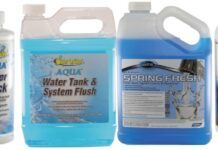
Keeping Water Clean and Fresh

Vinyl Boat Lettering DIY Application and Repair

Those Extras you Don’t Need But Love to Have

Three-Model BBQ Test

Alcohol Stoves— Swan Song or Rebirth?

UV Clothing: Is It Worth the Hype?

Preparing Yourself for Solo Sailing

How to Select Crew for a Passage or Delivery

Preparing A Boat to Sail Solo

Dear Readers

Chafe Protection for Dock Lines

Waxing and Polishing Your Boat

Reducing Engine Room Noise

Tricks and Tips to Forming Do-it-yourself Rigging Terminals
- Sailboat Reviews
Bristol Channel Cutter, Morris 40, Alerion Sloop
Three semi-custom cruisers - a gentleman's daysailer to blue-water passagemaker.
So often, we come away depressed from what has become a rite of autumn-the boatshow. It’s the same old story-nothing new under the sun. Oh, the giants like Catalina and Hunter may have squeezed in a 36 between their 35- and 37-foot models, or Beneteau may have some bizarre portlight design that catches your eye. But, you know the refrain: The more things change, the more things stay the same.
There’s another reason why the anticipation with which we approach each new season soon falters: mediocre quality. As certainly as the leaves will fall, we will hear from friends and readers who after the show say they were appalled at some of the practices employed by boatbuilders: sloppy fiberglass and joinerwork, nonmarine grade parts, unsafe design elements and the like.
One might take this as a snipe at production methods, where cost cutting is the watchword, and that it is elitist to always demand better. We, like you, simply cannot afford top drawer. But still we like to look, and during the last year we’ve been aboard a handful of boats that just made us feel good to sit in the cockpit, a properly proportioned and contoured coaming supporting our aching back, running our finger over a tight mortise (no filler), and looking below to a cozy, well-appointed cabin, feeling drawn toward what designer Robert Perry calls the boy’s cabin-in-thewoods (which we understand as a sort of primal approach-avoidance behavior: seeking, and taking a mysterious delight in, a safe haven in the danger zone). Herewith are descriptions of three boats we’d be delighted to call our own, but due to financial constraints, probably never will.
The Alerion
Nathaniel Herreshoff, the famed “Wizard of Bristol,” designed this 26-foot gentleman’s daysailer in 1912. We believe he built two himself, one ( which now resides at the Mystic Seaport Museum) that he sailed near his homes on Narragansett Bay and Ber-muda, and another, Sadie, that lives at the St. Michael’s Maritime Museum on Chesapeake Bay.
So the Alerion’s history is a long one: Nathaniel’s grandson Halsey designed a 25-foot fiberglass version for limited production, one of which was eventually bought by Alfred Sanford. In 1978 Sanford’s sons built a cold-molded wood version of the original Alerion on Nantucket (except that it was a half-foot beamier, toaccommodate a modest interior, slightly shorter on the waterline, and had a small cutaway in the aft section of the keel). They were beautifully made and the 20 sold are hard to come by on the used market. More recently, Carl Schumacher designed the 28- foot Alerion Express, which was first built by Holby Marine and now is built by TPI. The idea behind the Express was to combine the best elements of traditional looks with a modern “go fast” hull and appendages.
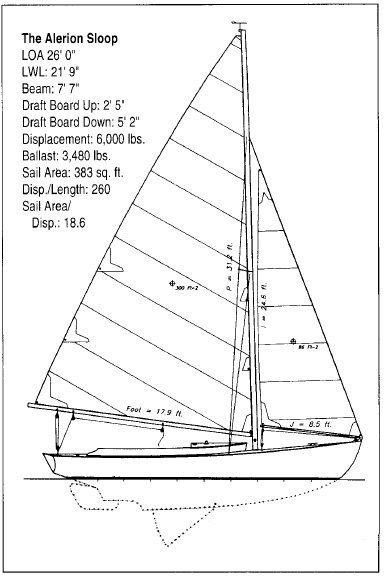
Which brings us to the latest incarnation of the Alerion, which is more or less faithful to Nathaniel Herreshoff s design (two differences: Capt. Nat’s hada gunter rig, and, unlike this adaptation, did not have a balanced rudder). It is built by Rumery’s Boatyard in Biddeford, Maine, and “represented” by Kingman Yacht Brokerage in Cataumet, Massachusetts. The hull is constructed of vinylester resin with a Divinicell foam core; the deck is cored with balsa. The house sides, coamings, toe rails, cockpit seats, cockpit and cabin soles, and louvered cabin doors are teak. The rudder post and hardware are bronze. The boat we saw had a Hall Spars aluminum mast (wood is optional) with Harken blocks, jiffy reefing, and a self-tending jib. Ballast is cast lead, internally positioned.
Rumery’s intends to build just five or six a year, so there is a good deal of latitude in fitting out. Hull #1 has overnight accommodations that include a V-berth, small galley, navigation surface and reading chair. One may choose a varnished oak or spruce ceiling. Optional is a Yanmar diesel (it seems almost sacrilegious to soil the bilge of this beauty with the oil that surely drips from an inboard).

We have two strong recollections of the Alerion. The first was in 1974, sailing Sadie on the Chesapeake Bay. The helm was effortless, and the hull seemed to move through the water with very little turbulence. She seemed not heavy, not light-just strong enough, and the proportions perfect. The second was perhaps 10 years later, on a rough day in Rhode Island Sound. We were hammering along in our Pearson Triton and came upon Ron Barr (who owns the Armchair Sailor bookstore in Newport) and a friend, seated low in the deep cockpit, their heads as well protected as could be expected in a boat with such a low coachroof. Indeed, one is nothing if not comfortable in the cockpit of an Alerion. Priced at $52,500 with sails, you’d expect as much.
Contact- Kingman Yacht Brokerage, 1 Shipyard Lane, Cataumet, MA 02534; 508/563-7136.
The Bristol Channel Cutter
Lyle Hess today is an old man, losing his vision, which must be especially tough for one who likes to designboats, spending hours at the drafting table. But what an eye he had! Probably best known as the man who designed Lin and Larry Pardey’s Seraffyn and Taleisin, Hess has also drawn several fiberglass production cruisers, including the 22-foot Falmouth Cutter and 28-foot Bristol Channel Cutter, or BCC for short.
The BCC, inspired by British work boats, is a heavy displacement cruising boat with a long waterline, short overhangs, full keel and big rudder. The cockpit, while small (it holds just 700 lbs. of water if filled) is quite comfortable, with generous backrests. The tiller does sweep much of its length, but is removable at anchor or when steered by a trim tab-type vane, as was fitted to Charles and Janet Smith’s boat when we went aboard in Newport Harbor this past summer. Theirs, called Freehand Steering, has a cloth vane attached to the backstay, which activates a trim tab hinged to the trailing edge of the rudder. This is a simple, very powerful type of mechanical self-steering.
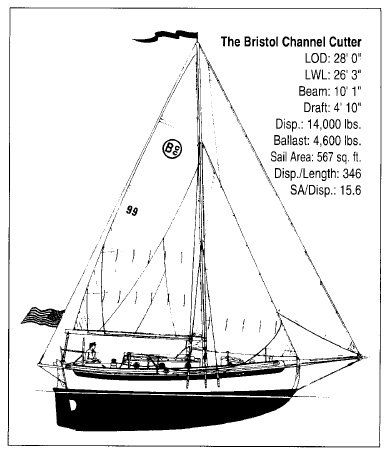
Charles is 6′ 6″ tall. He told us he and his wife were looking for something larger than their Tanzer 22, a durable cruising boat in terms of both construction and aesthetic. They approached Roger Olson, one of the partners who bought the Sam L. Morse Co. in 1994. Roger had cruised a BCC for 13 years in the South Pacific and knows the boat intimately. (He tells a funny story about working in the voluminous lazarette one day with the cover propped open. The boat moved, the tiller swung over and knocked the cover down, the hasp locking at the same time. He pounded until his girlfriend returned from shore and rescued him from his embarrassing yet serious plight. The hasps on all BCCs are now installed upside down.) In production since 1980, the details are much refined.
Back to Charles and his height problem. Olson arranged (for three grand) to lower the sole 1″ and to cut off the coachroof of the cabin mold and raise the height 4″ so Charles didn’t have to wear a hard hat. They did an excellent job; it does not look at all ungainly.
The BCC is not a fast boat, but performs very well for what she is. If you read Ferenc Mate’s book, The World’s Best Sailboats, he will tell you about a BCC that made the 3, 150-mile passage from California to the Marquises in 22 days, averaging 5.8 knots, with a one-day run of 180 miles averaging 7-1/2 knots. That was Roger Olson, who, being a salesman now, will also advise you of these facts whether you’re interested or not. Certainly they are noteworthy.
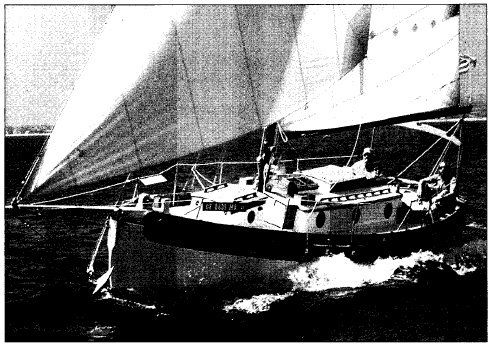
The hull is solid fiberglass with 3/4″ bulkheads bonded on both sides to the hull; they even drill holes through the bulkhead so that the cured resin locks it in place.
Contributing to the appeal of the BCC is the scuttle hatch forward. This not only looks salty, but provides a secure deck area just abaft to work the mast. The drawback is the need to stoop when going forward from the saloon to the head, which is located under the hatch. The 8″ bulwarks, bowsprit and bronze portlights continue the theme.
This is a go-anywhere boat, which, like the Alerion, is a piece of furniture (we’d varnish the raw interior teak pretty damn quick) that you hope your children will cherish when you pass on. The Smiths paid about $140,000 when all was said and done (radar, steering vane, sails, etc.). Base price is $122,500. The smaller Falmouth Cutter sells for $74,900.
Contact- Sam L. Morse Co., 1626 Placentia Ave., Costa Mesa, CA 92627; 714/645-1843.
The Morris 40
Tom Morris has been working the European market for some years now, principally Great Britain. In 1980, he licensed Victoria Marine to build his Frances 26 and Leigh 30 as the Victoria 26 and 30. Now he is licensed to build the Bowman 40 as the Morris 40. All are designed by Chuck Paine, a union too successful to mess with.
Paine says that he and Morris “Americanized” the Bowman for the U.S. market. This involved adding 11″ to overall length, a bulb keel, taller rig and reduced weight. He calls the Morris 40 the “ultimate short-handed offshore yacht with sufficient speed for racing potential.”

Morris eschews cored hull construction, but over time has felt the need to reduce the weight of a solid fiberglass hull. He now uses what he calls Rib-Core construction, which he says, “is engineered using longitudinal and transverse stiffeners encapsulated in the final inside laminate supported by the interior monocoque structure bonded to the hull and deck.” This makes for a stiffer hull and a weight savings of 25% . A cored hull, he estimates, would save an additional .9 lbs. per square foot of hull laminate. He makes up some of the difference with a few tricks such as using cored bulkheads. We think it’s a very sound approach. We also like the fact that he uses all vinylester resin in the lay-up-more expensive, but with superior bonding and blister resistance properties. If you want to know more, read our review of the similarly constructed Morris 44 in the March 15, 1994 issue.
The low-profile coachroof provides excellent visibility for the helmsman, even without a humped seat. The side decks are wide and the foredeck easily worked. A custom weldment carries two anchors ( we always anchor with two-a lightweight and a plow-a practice encouraged if they don’t have to be untied or lifted out of a locker).
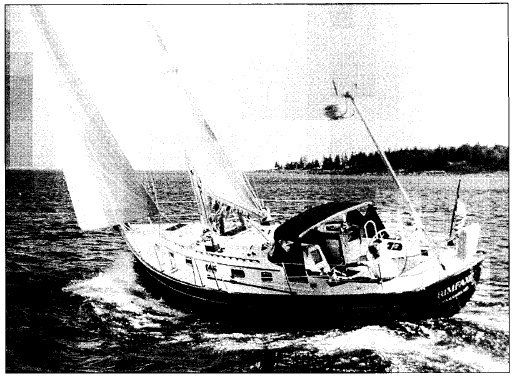
The engine is located under part of the galley, close to midships. Paine says this “further improves windward ability by reducing the mass moment of inertia of the yacht in pitching mode.” (Chuck, where were you when we were attacked by readers for saying that keeping the ends light minimizes hobby horsing?).
The interior, of course, is exquisite, with much allowance for customization. It is essentially laid out for two couples (two double berths, two heads), though families could opt for single berths to separate the children. The joinerwork is as good as any we’ve seen, here or abroad. Varnishing it will cost about $17,000, but having varnished the interiors of several boats ourselves, we are beginning to understand why it costs so much.
The Morris boats are, to our minds, a very successful combination of Paine’s enduring style and Morris’ quality construction; add the maximized performance obtained from the pared-away underbody and intelligent weight reductions and you get a boat that sails much quicker than it looks. The price sheet starts at $345,000, and the next slot in the production schedule is March 1996.
Contact-Morris Yachts, Clark Point Rd., Southwest Harbor, ME 04679; 207 /244-5509.
RELATED ARTICLES MORE FROM AUTHOR
Leave a reply cancel reply.
Log in to leave a comment
Latest Videos

Pearson 37 & 37-2 – Behind the Curtain

How To Test a Boat Engine

Hunter Legend 35.5 – Behind the Curtain

Whipping Line On Your Sailboat
Latest sailboat review.

- Privacy Policy
- Do Not Sell My Personal Information
- Online Account Activation
- Privacy Manager
About the BCC
...a serious pedigree.
Very few boats have the pedigree of the Bristol Channel Cutter both historically and as an icon of bluewater cruising.
Famed yacht designer, Lyle C Hess, originally based the design for the Bristol Channel Cutter (BCC) on the legendary Bristol Pilot Cutter - the epitome of yacht design in the mid 1800s to early 1900s.
Performance born from necessity
These Pilot Cutters had to be incredibly quick, yet highly seaworthy to race out to the incoming tall ships that were desperate for an experienced sailor to take the helm and pilot the valuable ship to safety through the notorious Bristol Channel.
The Bristol Channel has a fearsome reputation, with the UK's (and the World's second) highest tides. The ferocity of water movements combined with the underwater geography makes the Bristol Channel a highly dangerous place for seafarers.
Each Pilot Cutter raced it's peers to reach the incoming ship first - where the prize was the piloting job. This started an 'arms race' of boat technology that was the precursor to today's modern yacht racing - making the ship design incredibly important worldwide.
In the late 1960s, American yacht designer Lyle C Hess used this knowledge to create a series of boats which were incredibly seaworthy, yet had an impressive turn of speed - especially in light winds. Renegade of Newport, based in California was one such boat, and it's impressive racing career caught the eye of a young Larry Pardey - an ambitious young Canadian sailor looking for adventure.
Between Lyle and Larry the plans for Serrafyn of Victoria were born, and Larry successfully built the boat by hand and sailed her with his wife Lin for over 10 years - circumnavigating the world in the process. Looking for something bigger and more capable, the Pardeys once again called on Lyle C Hess for their next boat - Taleisin - which has safely taken them over 200,000 nautical miles.
Bristol Channel Cutters are produced in a variety of construction methods, including:
- Wood / glass fibre composites
The BCC class today...
One of the reasons BristolChannelCutter.org was started was to bring some order and consistency to the class online.
There's no one place for BCC info, and it's quite hard to find what your looking for. Ideally this site aims to connect people and grow the class - perhaps even getting some events underway so that likeminded individuals and supporters can get together, have a great time, swap stories and hang out.
The Goals of BCC.org:
- Encourage and grow the network of BCC owners and fans worldwide
- Document every BCC still in existence
- Provide access to a wide range of BCC images, videos, articles and resources to inspire and educate
- Encourage people interested in BCCs to get involved and find their closest Bristol Channel Cutter
Great choice! Your favorites are temporarily saved for this session. Sign in to save them permanently, access them on any device, and receive relevant alerts.
- Sailboat Guide
1981 Sam Morse Bristol Channel Cutter 28
- Description
Seller's Description
Rare example of a Sam Morse built BCC 28, has been well cared for with factory built cabin interior. Widespread use of teak with raised panel cabinet doors, drawer fronts, sole, and furniture. Slide out single berth converts to double. Sea berth and quarter berth sleeps 4. Propane stove and cabin heater, cold plate refrigeration, pressurized hot/cold water, Cockpit shower, wash down pump, LED bunk lights, and 3 gimbaled oil lamps. A full refit in 2012 replaced mast and standing rigging by Brion Toss. New Mainsl, Staysl, roller furled Jib with protective cover by Carole Hasse, Canvas covers for all deck hatches, boxes, companionway, bulwarks, Mainsl and Staysl. Re powered with Yanmar 3YN30 diesel with fuel polishing system, feathering Max Prop, 4 deep cycle house batteries, 1 starting battery, solar panel with battery monitor, LED running, tri color masthead and anchor lights. Tiller autopilot, Monitor windvane, VHF, Class B AIS Transponder, EPIRB. New in 2022; Raymarine Anemometer, Raymarine color radar/plotter, all running rigging replaced, all sails cleaned and serviced. New 2019 Cockpit cushions, and Cabin cushions, Fresh/salt water foot pumps at galley sink, gravity drain waste tank, groco marine head, Pullman flip up hand wash sink in head, lots of storage, hanging locker. Fatty Knees dinghy with deck chocks. Winter canvas cover. A well found vessel, smooth bottom, ready to take you as far as you care to go!
Equipment: See description
Rig and Sails
Auxilary power, accomodations, calculations.
The theoretical maximum speed that a displacement hull can move efficiently through the water is determined by it's waterline length and displacement. It may be unable to reach this speed if the boat is underpowered or heavily loaded, though it may exceed this speed given enough power. Read more.
Classic hull speed formula:
Hull Speed = 1.34 x √LWL
Max Speed/Length ratio = 8.26 ÷ Displacement/Length ratio .311 Hull Speed = Max Speed/Length ratio x √LWL
Sail Area / Displacement Ratio
A measure of the power of the sails relative to the weight of the boat. The higher the number, the higher the performance, but the harder the boat will be to handle. This ratio is a "non-dimensional" value that facilitates comparisons between boats of different types and sizes. Read more.
SA/D = SA ÷ (D ÷ 64) 2/3
- SA : Sail area in square feet, derived by adding the mainsail area to 100% of the foretriangle area (the lateral area above the deck between the mast and the forestay).
- D : Displacement in pounds.
Ballast / Displacement Ratio
A measure of the stability of a boat's hull that suggests how well a monohull will stand up to its sails. The ballast displacement ratio indicates how much of the weight of a boat is placed for maximum stability against capsizing and is an indicator of stiffness and resistance to capsize.
Ballast / Displacement * 100
Displacement / Length Ratio
A measure of the weight of the boat relative to it's length at the waterline. The higher a boat’s D/L ratio, the more easily it will carry a load and the more comfortable its motion will be. The lower a boat's ratio is, the less power it takes to drive the boat to its nominal hull speed or beyond. Read more.
D/L = (D ÷ 2240) ÷ (0.01 x LWL)³
- D: Displacement of the boat in pounds.
- LWL: Waterline length in feet
Comfort Ratio
This ratio assess how quickly and abruptly a boat’s hull reacts to waves in a significant seaway, these being the elements of a boat’s motion most likely to cause seasickness. Read more.
Comfort ratio = D ÷ (.65 x (.7 LWL + .3 LOA) x Beam 1.33 )
- D: Displacement of the boat in pounds
- LOA: Length overall in feet
- Beam: Width of boat at the widest point in feet
Capsize Screening Formula
This formula attempts to indicate whether a given boat might be too wide and light to readily right itself after being overturned in extreme conditions. Read more.
CSV = Beam ÷ ³√(D / 64)
From BlueWaterBoats.org :
With all the nostalgia of yesteryear the Bristol Channel Cutter 28, introduced in 1975, represents a pinnacle of ruggedness and practicality while retaining respectable performance. Few boats can take the abuse of extended voyaging as well as the Bristol Channel Cutter and I guess it’s become something of a Lyle Hess masterpiece.
Late designer Lyle Hess achieved somewhat of a cult following among a select group of small boat adventurers. In particular his designs were popularized by Lin and Larry Pardey and their series of cruising books. Hess is probably best known for Lin and Larry’s 24 foot Seraffyn and their subsequent 29 foot Teleisin . And really when you dig a little deeper, you’ll find the Bristol Channel Cutter was created in answer to sailors wanting a “Pardey” yacht.
Bad puns aside, among the endearing features for the long distance sailor are huge stowage, a sensible layout and a proven track record. Besides Serrafyn and Teleisin’s well known 40,000 mile circumnavigation and five passages of the potentially treacherous Tasman Sea, a Bristol Channel Cutter was first in the Newport to Ensenada Race of 1978, and first in class in 1979. And in the 1980-1990s Roger Olson sailed his Bristol Channel Cutter Xiphias 50,000 miles over a thirteen year two-ocean odyssey.
Upon first glance the sheer size of the bowsprit is noticeable, together with a bumpkin, the boat can carry an immense amount of canvas for her displacement. A peek under her waterline reveals lines that look conservative and traditional. There’s the familiar wineglass section profiles and a full keel that’s missing the popular forefoot cutaway that many designers employ to improve nimbleness and reduce drag. Yet on closer inspection performance tweaks can be found. A fine bow entry coupled with maximum beam quite far aft is good for close windedness and flat sections with minimal deadrise aft aid righting efforts when heeled over under sail.
The Bristol Channel Cutter’s layout has been thoughtfully designed to the minute details, we hear even the smallest of owner modifications will have ramifications elsewhere. Fitting for this kind of sailboat, don’t expect staterooms designed for time on anchor – all berths are seagoing. There’s four of them – two settees, a pilot berth, and the all important quarter berth. Stowage is abundant and everywhere. In short a long distance voyager’s dream.
So the story goes, a friend of Lyle Hess asked for a small traditional boat that would cross oceans. To that commission, Hess presented his interpretation of the pilot boat designs which had proven themselves in the 19th century. These workboats were heavy in displacement, long in waterline with wineglass sections and hard bilges. Their rigs carried lots of canvas, they’d lug a lot of cargo, and could sail fast on all points of sail.
Hess’ initial design was a 28 footer, which then was scaled down to a gaff-rigged 24 foot design to mitigate his friend’s concern over construction cost. This boat became Renegade of Newport , launched in 1950. By the 1960s the Renegade caught the interest of Larry Pardey. Upon request Hess drew up plans for a marconi-rigged version for carvel wood construction. This boat became Seraffyn which launched in 1968.
Through the magic of books and articles written by the Pardeys, an interest in small boat voyaging emerged with the famous Pardey tagline “go small, go simple, go now”. It drew attention to Hess’ work and Hess answered this interest by designing the 28 foot Bristol Channel Cutter, for construction in fiberglass by the Sam L. Morse Company. The Bristol Channel Cutter 28 launched in 1975.
In 1992, before a recession, Morse sold the company he founded to a Hess fan named George Hylkema, who hired Roger Olson, fresh from his 50,000 mile world cruise onboard Xyphias brimming with ideas to improve the boat. Olson bought the business in 1995 before selling the company only three years later in December 1998 to the fourth and final owner, Sumio Oya.
By 2007, Sam L. Morse Company was struggling to be viable. Its classic boats were in less demand and profits tended to be found in building much larger vessels. New mass production technologies from other manufacturers made it harder to compete. After the completion of its 126th hull, Cape George Marine Works was given the molds along with the right to build both the Bristol Channel Cutter and the Falmouth Cutter 22 . For Sumio Oya, it was important to protect the quality and reputation of the boat so upon selecting Cape George to carry on the name, the deal involved no money apart from the cost of relocating the molds which was paid by Cape George. Before closing, Sam L. Morse Company did consider the opportunity to build a larger Hess boat but in the end there was not enough capital to launch the project.
The company continued operation through to August 2008 helping Cape George build two more Bristol Channel Cutters before finally shutting down, leaving Cape George to carry on availability. Since then Cape George rolled out an additional hull in January 2011.
Beyond the 129 American boats it is estimated between 30-45 hulls were built in a Canadian yard called Channel Cutter Yachts located in Vancouver, BC. These were bootleg versions for which no design royalties were paid. From what we hear the Canadian boats were also built to a very high standard.
Links, References and Further Reading
» Bristol Channel Cutter / Falmouth Cutter Owners website, information, images and discussions . » Lyle Hess: A Profile by Chuck Malseed, a historic look at his work, Cruising World Magazine Feb, 1977. » The Bristol Channel Cutter 28 on the official Cape George Marine Works website . » Bristol Channel Cutter Review by Jack Horner, BoatUS.com » Bristol Channel Cutter Review, Boats.com , Aug 2000 » A vintage video tribute to the Bristol Channel Cutter including construction details.
This listing is presented by SailboatListings.com . Visit their website for more information or to contact the seller.
View on SailboatListings.com
Embed this page on your own website by copying and pasting this code.
Similar Sailboats For Sale

1978 37' BRISTOL CHANNEL CUTTER
- About Sailboat Guide
©2024 Sea Time Tech, LLC
This site is protected by reCAPTCHA and the Google Privacy Policy and Terms of Service apply.

IMAGES
VIDEO
COMMENTS
A boat with a BN of 1.6 or greater is a boat that will be reefed often in offshore cruising. Derek Harvey, "Multihulls for Cruising and Racing", International Marine, Camden, Maine, 1991, states that a BN of 1 is generally accepted as the dividing line between so-called slow and fast multihulls.
Sailboat and sailing yacht searchable database with more than 8,000 sailboats from around the world including sailboat photos and drawings. Toggle Navigation ... Bristol Channel Cutter class site. Related Sailboats: Model LOA First Built; BRISTOL CHANNEL CUTTER: 28.08: 1976
Bristol Channel Cutter . www.bristolchannelcutter.org. Bristol Channel Cutter class site. Related Sailboats: Sort by: ... 1 Sailboats / Per Page: 25 / Page: 1. 0 CLICK to COMPARE . MODEL LOA FIRST BUILT FAVORITE COMPARE; BRISTOL CHANNEL CUTTER: 28.08 ft / 8.56 m: 1976: ShipCanvas ...
Bristol Channel Cutter is a 37′ 9″ / 11.5 m monohull sailboat designed by Lyle C. Hess and built by Cape George Marine Works and Sam L. Morse Co. starting in 1975. ... Beyond the 129 American boats it is estimated between 30-45 hulls were built in a Canadian yard called Channel Cutter Yachts located in Vancouver, BC. These were bootleg ...
The Bristol Channel Cutter, also called the Bristol Channel Cutter 28, is an American sailboat that was designed by Lyle Hess as a "character boat" cruiser and first built in 1976. [1] [2] [3] The boat is based upon Hess's earlier Renegade design.
Blue Water Surf Value Rank (BWSVR) 2074. Capsize Comfort Value Rank (CCVR)
Based on his experience as a hands-on boater, he established a marine-based business after completing his police career. He now maintains, renovates and upgrades sail and power boats for local and non-resident owners in the off-season. This sturdy Bristol Channel Cutter 28 has survived vast ocean gales and knockdowns.
The Bristol channel cutter is a 28.08ft cutter designed by Lyle Hess and built in fiberglass by Cape George Marine Works between 1976 and 2007. 127 units have been built. The Bristol channel cutter is a heavy sailboat which is a good performer. It is stable / stiff and has an excellent righting capability if capsized.
But, if you're lucky enough, you'll stumble upon one of the modern gems in the sailing industry, the 28-foot Bristol Channel Cutter. While it's still made of fiberglass like most of its contemporary counterparts, the BCC looks and feels like an old, wooden English workboat. Its long bowsprit and wide decks make this stout little boat look three ...
Much has been written about the Bristol Channel Cutter from the Sam L. Morse Company, and we will let these articles speak for themselves: This site is dedicated to owners and aficionados of the Bristol Channel Cutter and The Falmouth Cutter, vessels designed by the late Lyle Hess, and built primarily by the Sam L. Morse company in Costa Mesa ...
By Barbara Marrett. Updated: November 4, 2001. The Bristol Channel Cutter caused a veritable traffic jam at the 1995 Annapolis Boat Show. Certainly she is a niche boat with a fiercely loyal following among long-distance cruisers. Cruiser/authors Lin and Larry Pardey, whose boats Seraffyn and Taleisin are also Lyle Hess designs, have always been ...
BRISTOL CHANNEL CUTTER 28: A Salty Pocket Cruiser. THIS IS A VERY TRADITIONAL CRUISING BOAT that evokes a strong emotional response from most sailors, but is also surprisingly functional and performance-oriented for a vessel of its size and type. Conceived by Lyle Hess, the BCC 28 is based on earlier Hess designs built in wood-specifically ...
Easily the most famous of all Bristol Channel Cutters, this diminutive 24' boat has a serious large pedigree, with 100,000's of miles under her keel. Built by Larry and Lin Pardey, this BCC was the star of the couple's 4 sailing books. 24 foot. 30 foot. Taleisin of Victoria.
Indeed, one is nothing if not comfortable in the cockpit of an Alerion. Priced at $52,500 with sails, you'd expect as much. Contact- Kingman Yacht Brokerage, 1 Shipyard Lane, Cataumet, MA 02534; 508/563-7136. The Bristol Channel Cutter. Lyle Hess today is an old man, losing his vision, which must be especially tough for one who likes to ...
Created by Dave and Meesh. On a wee island in the roaring 40s! Find every Bristol Channel Cutter in existence. Ranked by boat length, including 24', 28', 30' and 32' Lyle C Hess designs. If you want to nominate a boat for inclusion then use our simple form.
How much do Bristol Channel Cutter boats cost? Bristol Channel Cutter boats for sale on YachtWorld are offered at a variety of prices from $89,900 on the lower-cost segment, with costs up to $165,900 for the more lavish yachts on the market today.
About the BCC. ...A Serious Pedigree. Very few boats have the pedigree of the Bristol Channel Cutter both historically and as an icon of bluewater cruising. Famed yacht designer, Lyle C Hess, originally based the design for the Bristol Channel Cutter (BCC) on the legendary Bristol Pilot Cutter - the epitome of yacht design in the mid 1800s to ...
Find Bristol Channel Cutter 28 boats for sale in your area & across the world on YachtWorld. Offering the best selection of Bristol Channel Cutter boats to choose from. ... 1982 Bristol Channel Cutter 28. US$102,226. United City Yachts Inc. | Vancouver, British Columbia. Request Info; Sponsored Boats | related to your search. 2006 Chaparral 276 ...
1978 28′ SAM MORSE BRISTOL CHANNEL CUTTER Price : $67,500 Length: 38' Location : Wiscassette, Maine. Description: ... Beyond the 129 American boats it is estimated between 30-45 hulls were built in a Canadian yard called Channel Cutter Yachts located in Vancouver, BC. These were bootleg versions for which no design royalties were paid.
To provide the best experiences, we use technologies like cookies to store and/or access device information. Consenting to these technologies will allow us to process data such as browsing behavior or unique IDs on this site. Not consenting or withdrawing consent, may adversely affect certain features and functions.
Description. 2010 Bristol Channel Cutter BCC 28. Stravagin ll is a wonderful example of the Lyle Hess-designed and Sam Morse-built Bristol Channel Cutter! She was a hull and deck version that was purchased by a Maine schooner Captain who planned to finish her off himself. She was trucked across to Maine but sat in storage for a year.
It drew attention to Hess' work and Hess answered this interest by designing the 28 foot Bristol Channel Cutter, for construction in fiberglass by the Sam L. Morse Company. The Bristol Channel Cutter 28 launched in 1975. In 1992, before a recession, Morse sold the company he founded to a Hess fan named George Hylkema, who hired Roger Olson ...
Original builder of Bristol Channel Cutter and Falmouth Cutter Location was: 1626 Placentia Ave. Costa Mesa, CA 96267 (USA) Years in Business: 1976 - 2007. Sailboats Built By Sam L. Morse Co. (USA) (Dates indicate when boat was first built by any builder) Sort by: